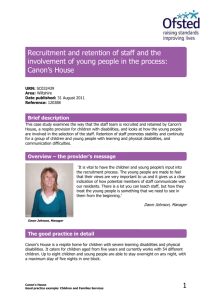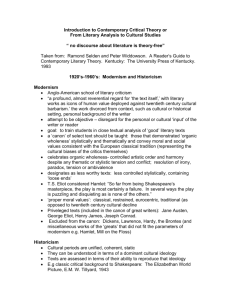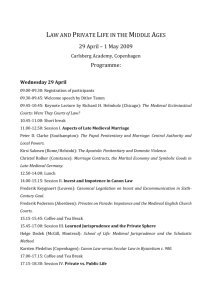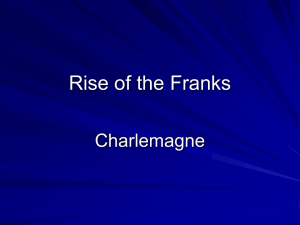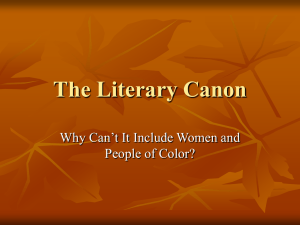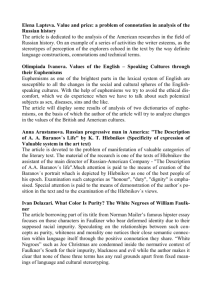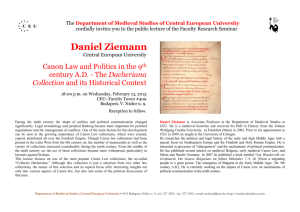The Literary Canon: implications for the teaching of language as
advertisement
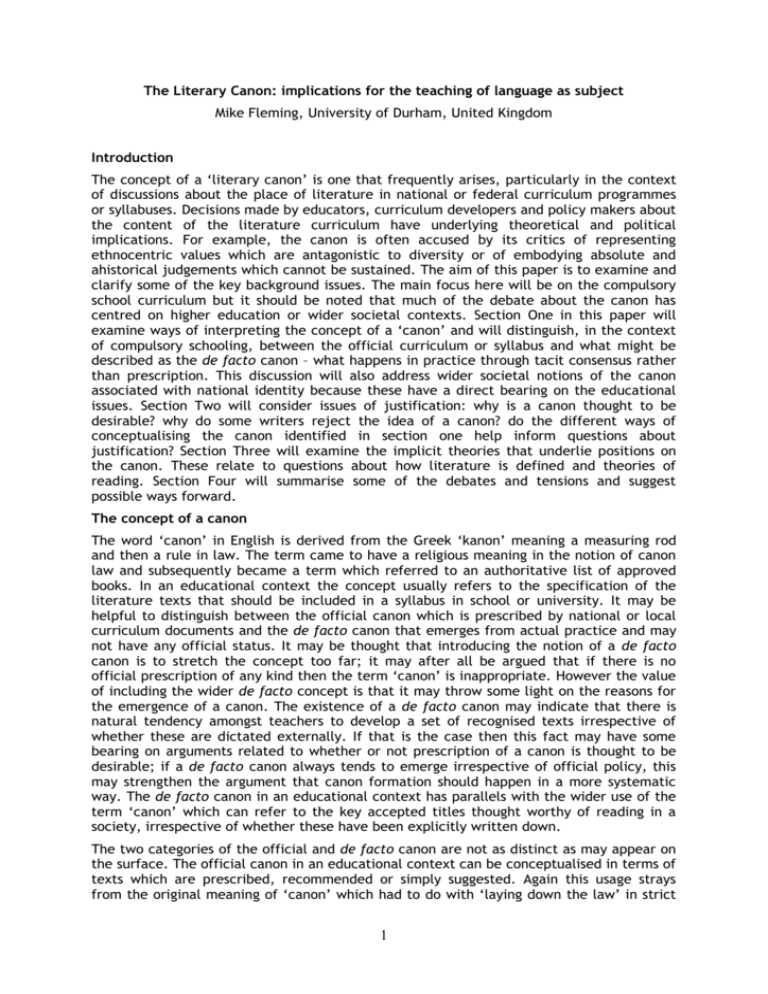
The Literary Canon: implications for the teaching of language as subject Mike Fleming, University of Durham, United Kingdom Introduction The concept of a ‘literary canon’ is one that frequently arises, particularly in the context of discussions about the place of literature in national or federal curriculum programmes or syllabuses. Decisions made by educators, curriculum developers and policy makers about the content of the literature curriculum have underlying theoretical and political implications. For example, the canon is often accused by its critics of representing ethnocentric values which are antagonistic to diversity or of embodying absolute and ahistorical judgements which cannot be sustained. The aim of this paper is to examine and clarify some of the key background issues. The main focus here will be on the compulsory school curriculum but it should be noted that much of the debate about the canon has centred on higher education or wider societal contexts. Section One in this paper will examine ways of interpreting the concept of a ‘canon’ and will distinguish, in the context of compulsory schooling, between the official curriculum or syllabus and what might be described as the de facto canon – what happens in practice through tacit consensus rather than prescription. This discussion will also address wider societal notions of the canon associated with national identity because these have a direct bearing on the educational issues. Section Two will consider issues of justification: why is a canon thought to be desirable? why do some writers reject the idea of a canon? do the different ways of conceptualising the canon identified in section one help inform questions about justification? Section Three will examine the implicit theories that underlie positions on the canon. These relate to questions about how literature is defined and theories of reading. Section Four will summarise some of the debates and tensions and suggest possible ways forward. The concept of a canon The word ‘canon’ in English is derived from the Greek ‘kanon’ meaning a measuring rod and then a rule in law. The term came to have a religious meaning in the notion of canon law and subsequently became a term which referred to an authoritative list of approved books. In an educational context the concept usually refers to the specification of the literature texts that should be included in a syllabus in school or university. It may be helpful to distinguish between the official canon which is prescribed by national or local curriculum documents and the de facto canon that emerges from actual practice and may not have any official status. It may be thought that introducing the notion of a de facto canon is to stretch the concept too far; it may after all be argued that if there is no official prescription of any kind then the term ‘canon’ is inappropriate. However the value of including the wider de facto concept is that it may throw some light on the reasons for the emergence of a canon. The existence of a de facto canon may indicate that there is natural tendency amongst teachers to develop a set of recognised texts irrespective of whether these are dictated externally. If that is the case then this fact may have some bearing on arguments related to whether or not prescription of a canon is thought to be desirable; if a de facto canon always tends to emerge irrespective of official policy, this may strengthen the argument that canon formation should happen in a more systematic way. The de facto canon in an educational context has parallels with the wider use of the term ‘canon’ which can refer to the key accepted titles thought worthy of reading in a society, irrespective of whether these have been explicitly written down. The two categories of the official and de facto canon are not as distinct as may appear on the surface. The official canon in an educational context can be conceptualised in terms of texts which are prescribed, recommended or simply suggested. Again this usage strays from the original meaning of ‘canon’ which had to do with ‘laying down the law’ in strict 1 terms. However it is important to recognise the alternative uses of the term because some curriculum guidelines or syllabuses stop short of prescribing texts but do offer instead strong recommendations or suggestions. Whether it is appropriate to continue to use the term ‘canon’ for the practice of simply recommending texts or to use it to describe the natural emergence of a set of agreed texts (the de facto version) is less important than the insight these uses provide into the related arguments. Terms do not have static meaning and it is worth recognising that the different uses of ‘canon’ have at least a family resemblance which highlights some of the complexities of the issues. Arguments for or against the canon sometimes focus on a narrow, oversimplified definition or misunderstandings of how the term is being used by the antagonists. A further complication is that the official canon itself may be conceived in different ways – in terms of specification of titles of texts, authors, historical period or genres. Specification of specific titles or ‘canonical texts’ is the narrowest form of prescription. On the other hand, specifying authors rather than texts is also a form of prescription which leaves some latitude for local choices. The fact that not all the works written by an author are necessarily of the same quality highlights a weakness in this particular approach to the canon, particularly if the canon has been conceived as a specification of what is considered the best. Specifying titles and/or authors is the more typical way the canon is conceived in the wider society. Alternatively, a syllabus may specify the requirement to read texts within a specific historical period (the UK National Curriculum for example, as one of its requirements, requires the reading of texts published both before and after 1914). Some syllabuses use the notion of genre to determine types of texts which must be studied, prescribing for example the need to read poetry, prose and drama to ensure balance in pupils’ reading. It could be argued that the concept of canon is here once again being extended too far. However these are all ways in which syllabuses can set some sort of parameters for the study of literary texts rather than just leaving a completely free choice; for that reason they are worthy of consideration. When texts, authors or genres are specified for study this does not of course mean that the entire syllabus for an age group is necessarily pre-determined. It may be a case of specifying a minimum number of texts or authors while allowing the teacher or school latitude to choose other additional texts to foster wider reading. It is also important to acknowledge that these different approaches may be combined. For example a syllabus or national curriculum may require the reading of some specific texts as well a range of authors from a given list. It may also combine some specification of minimum requirements with latitude for local choices to acknowledge teacher and pupil interests and preferences. The concept of a canon in an educational context needs to pay attention to two axes or dimensions: one is information or content based (the specified authors, texts, genres, historical periods) and the other is process oriented (the way teachers approach the specified content). It is the dynamic or interplay between these two dimensions which is crucial in determining the educational experience of the pupils. Too often the canon debate is conceived only with regard to content. The literary curriculum is not just a matter of specification of texts but also needs to embody theoretical perspectives on reading and teaching. The de facto canon may also include literature written specifically for children which is sometimes excluded from the traditional canon because it has tended to focus more on established texts that have stood the test of time. Children’s literature or youth literature is an established genre and a field of academic study in its own right and the notion of children’s classic literature is recognised. Even so, it is easy to see how the idea of including certain types of literature written specifically for young people might be contested on the grounds that contemporary texts of this kind do not have the desirable aesthetic qualities and depth that might be expected of canonical texts. Underlying this 2 view are of course implicit theoretical views about the nature of reading and about judging quality. As indicated, a de facto canon can arise for a number of reasons, irrespective of whether or not there is a nationally prescribed set of texts or authors. There may be practical reasons for this. Classic texts may continue to be read because these are the ones that are readily available to schools operating with limited budgets. Teachers sometimes hear about texts that genuinely engage pupils through their formal and informal networks, and these become the accepted texts for study. Publishers may have an influence on the de facto canon not just in their choice of core texts and how they market them but also in relation to the availability of auxiliary texts of criticism. The writers of text books which are either officially approved or popular in schools may also have an impact on the canon. These may not necessarily reinforce tradition but may seek to challenge it by including a wider range of authors and genres (for example in Norway there has not been a strong official canon tradition but there has been a strong de facto curriculum in text books and classroom practices). There may however be less pragmatic reasons for the emergence of a canon. It may be that the emergence of a set of key agreed texts, irrespective of whether these are prescribed or not, is genuinely related to notions of quality and ‘high’ culture. According to Kennedy (2001:105) canon formation is a ‘natural human instinct’ which is an attempt ‘to impose order on variety by choosing what is best for preservation over time’. These issues of principle are of course related to justification arguments for and against the adoption of a canon to which this discussion will now turn. Justification Just as the concept of a canon is more complex than at first seems, so also are the arguments for and against its adoption in relation to the study of literature. The traditional criteria for forming the canon have primarily been associated with notions of quality, selection of those texts or authors which are considered ‘the best’. However other related criteria were to do with selecting texts thought to be representative of a particular period, style or genre or those which have had an impact on culture historically and those which are thought to have a particular national significance. It is easy therefore to see why the canon has been criticised for preserving nationalist and ethnocentric values. The debate about the canon has often been fierce, particularly in the United States where in the 1980s and 1990s there was first an attack on the traditional canon and then a ‘conservative backlash’ against attempts to broaden it to make it more representative of society (Altieri, 1990: Guillory, 1993). Benton (2000:169) has referred to the ‘canon wars’ which raged in higher education between ‘those who supported a unitary canon and their challengers advocating pluralism’. Underlying arguments about justification then are ideological positions related to issues such as power, representation and academic freedom. It is tempting to see the canon debate in terms of stark polarisations between, for example, liberal and conservative views, high culture and relativism, separatist and inclusive accounts of art. However arguments about the canon do not necessarily fall neatly into established polar positions. Traditional arguments in favour of a canon focused on the need to preserve the best of a nation’s cultural heritage. More recently, arguments have centred on the need to have a wide variety of social groups represented in reading lists and that these need to be prescribed. The traditional elitist argument for a canon has thus been reversed to suggest that unless there is a representative canon, literary study in universities and schools will not be properly balanced. Arguments have centred not just on preserving or abolishing the canon but on how it should be revised. Different views of whether or not a canon is desirable therefore need to be considered in relation to the content of particular canons and how these operate. The importance of context becomes particularly important when considering issues of national identity and language. For newly independent, emerging 3 nations the canon may be symbolic of freedom, independence and the preservation of indigenous language and culture rather than representative of repression and power. Altieri (1990) has suggested that canons are almost always based on ‘normative claims’; a motivation to recognise, preserve and pass on to the next generation the literature that is considered the best. Kennedy (2001) has demonstrated the focus on normative judgements in the historical development of notions of the canon as an instinct ‘to preserve traditional knowledge and values against the erosion of time’. The importance of selecting a small number of works for posterity made particular sense in oral cultures where it was simply not possible to preserve every oral text. It was also a consideration in societies prior to the advent of mass print production which relied on some element of selection because of the effort needed in copying out texts. Issues of quality were central in the canon formation in various contexts. In classical times Alexandria librarians had begun to make lists of the poets they judged most deserving to be studied and kept. Almost all the works of Greek classical writers were lost: just seven plays each out of over a hundred written by Aeschylus and Sophocles were thought sufficient for teaching (ibid 109). This instinct to preserve what is thought of as the best survives from classical times to the present but judgments of quality have become problematic in contemporary debates. Few writers now would see the determination of a canon on the basis of simply choosing ‘the best’ as being an innocent matter; the implied absolutism has been questioned on theoretical, historical and cultural grounds. Eagleton (1983:11) emphasised the importance of seeing the canon, the unquestioned ‘great tradition’ as a ‘construct’: ‘there is no such thing as a literary value or tradition which is valuable in itself, regardless of what anyone might have said or come to say about it.’ Historical perspectives on literature which had been dormant for so long when new criticism was in the ascendancy, draw attention to the contextual nature of judgements; if a text has a different meaning to different generations, the idea of a static list of texts claiming universal quality must be open to question. It is also argued that the traditional idea of a canon does not acknowledge the significance of cultural differences sufficiently. This is hardly surprising because the canon has been associated with preserving national characteristics and values. According to Benton (2000) the challenge to the traditional canon has come from two main directions: from post-colonial, feminist and other theorists who, as part of an agenda for social and cultural change, have questioned the dominance of white, male, bourgeois canonical texts. Arguments for widening the canon have been part of an agenda for social reform. The other main challenge has come from curriculum modernisers with writers focusing more on making the curriculum relevant to young people in the modern age. The advent of film and other forms of media has questioned the exclusive focus on the written text which has tended to define the traditional canon. Modern technology has brought new access to resources and to different forms of texts. In addition, teachers who are faced with the reality of trying to interest young people in reading will often take a more pragmatic approach to choice of texts and argue that a genuine, engaged response to a more contemporary work is more worthwhile than incomprehension or indifference to an established canonical text. It could be argued that the traditional concept of the canon was based on unquestioning reverence and acceptance rather than a critical and questioning approach that is more likely to be found in contemporary pedagogy. It could also be argued that the traditional canon diminishes teacher autonomy and underestimates teachers’ abilities to choose appropriate texts for pupils; the implicit view here it that it is not possible to legislate for good teaching which develops only when there is an active, involved, independent, thinking profession. Arguments about the canon in relation to the school curriculum cannot be entirely disassociated from questions about pedagogy and means, nor from consideration of the aims and purposes of literature teaching. If literature teaching is associated with identity formation, language learning, understanding culture, developing values and even coming 4 to terms with the past, then choice of texts will be a relevant, if not the only factor determining the nature of the learning involved. (For a more detailed discussion of the aims of literature teaching see the paper Text, literature and “Bildung” – comparative perspectives: Section I) In the contemporary school curriculum, literature is more likely to be seen as an integrated component of ‘language as subject’ with the literary texts serving as a focus for the development of communicative competence and knowledge about language, as well as for the development of what have traditionally been seen as more purely ‘literary’ competencies (ability to analyse formal elements of texts, discussion of themes and characters etc.). These perspectives all have a bearing on choice of texts for study. Many of the arguments in favour of the canon have emerged largely in response to the challenges which have been advanced in the last forty or so years; before that, the existence of the canon tended to be taken for granted. Many of these arguments then are not just a reassertion of naïve, fundamentalist views but are advanced with a more sophisticated understanding of the literary theoretical ideas which have informed the criticisms. Bloom (1995) for example has re-asserted the significance of the aesthetic in response to literature and criticised the different politicised approaches to literary theory, calling them ‘The School of Resentment’. The traditional idea of the canon was based on authority as evidenced by the historical origins of the term. However an alternative view, based on some form of consensus, suggests that the canon is not necessarily static and immune from criticism and change, but may be a valuable focus for sharing perceptions and values within a community of practice. This type of argument is different from the traditional authoritarian notion of the static canon because it recognises its contextual and therefore dynamic nature. The canon may be associated with ideas related to preserving ‘cultural memory’; it provides a focus for collective identity and shared values. It should also be recognised that it may be the de facto rather than the official canon which is more a force for preserving traditional choices and approaches. This is for example the case in Romania as well as other countries where the official curriculum has sought to promote a more flexible approach to choice of texts and a more active approach in the classroom. The aim of incorporating contemporary ideas on teaching literature drawn from reception theory has not always been followed by actual practice in some classrooms which has tended to cling to established practices. In the context of formal schooling it may be argued that the choice of appropriate reading for young people should not be left entirely to the whim of the individual teacher but should be subject to some form of influence. The formation of the curriculum may be guided more by ideas of ‘entitlement’, the idea that pupils should have rights to particular content or experiences, rather than the imposition of arbitrary rules, places a different complexion on the specification of a canon. There are of course practical difficulties in determining how a national syllabus can be said to reflect consensus but this does not necessarily affect the principle that the canon may be associated with democratic rather than authoritarian ideas. The notion of entitlement can be linked with ideas related to ‘cultural capital’, the idea that all pupils have the right to be exposed to ‘key texts’ in society as part of an agenda for social inclusion. The canon tended to very traditional by nature. However, the notion of ‘quality’ is not just associated with texts from the past nor is the notion of ‘culture awareness’ associated only with historical ideas of cultural heritage. Understanding contemporary ideas happens partly through reading contemporary authors and texts; wider cultural awareness and understanding can be promoted by reading and comparing texts from different cultures. Guillory (1993) has drawn on the concept of ‘cultural capital’ to introduce a different dimension into the canon debate, arguing that it has been misconceived. In the United States in particular in the 1990s the debate was dominated by arguments that a variety of social groups should be represented; it was more a question of 5 reform than abolition of the canon. Guillory argues that canon formation should be understood as a question of the distribution of cultural capital in schools. In a culture of ‘universal access’ canonical texts would not be experienced as ‘lifeless monuments’ or as ‘proofs of class distinction’ (340), his argument is one in favour of universal access. The influence of theory Some of the underlying theoretical considerations related to debates about the canon have already been alluded to in this paper. These derive from literary and wider cultural and aesthetic theory and relate to such issues as the definitions of literature, different conceptions of what reading involves and the formation of judgements about literature. One of the challenges to the traditional notion of the canon has derived from contested ideas about the nature of literature itself, questioning whether it is possible to define it as a discrete, stable category. Theories which grew from the 1960s onwards started to question long-held assumptions about literature including ‘the idea of the author as the origin of a text’s meaning, the possibility of objective interpretation, the validity of the empirical historical scholarship and the authority of the literary canon’ (Lodge, 1988: xi). The first chapter of Eagleton’s (1983) seminal Literay Theory and Introduction was devoted to the problem of defining literature. The boundaries of what counts as literature are not always clear: some philosophical texts, letters, essays, sermons are often counted as literature. The concept of ‘fiction’ is not equivalent to literature (not all poetry is fiction) because it embraces other forms of narrative including film. According to some writers (Aston and Savona, 1991), drama may be studied as literature or as theatrical process or performance with the suggestion that these approaches are not identical. All sorts of texts can be written in a literary style without necessarily defining these as literature per se. Some contemporary theorists have defined literature not in terms of intrinsic, essentialist criteria but in relation to how a particular text is read – whether it is read purely for functional purposes, for the information it supplies, or whether there is an aesthetic dimension to the response to the text. The converse position is that a recognised literary text may be read in a purely functional way. Given the fluidity of the boundaries, there may be an argument to suggest that the key curriculum decision is not so much about specifying texts or authors in relation to a literary canon but rather should focus on whether a range of different types of reading should be prescribed including fiction and non-fiction texts. It has been suggested that the traditional canon centred largely on issues of quality and was associated with preserving what was thought to be ‘the best’. Much contemporary thinking has challenged the making of absolute judgements in such a simple way but, on the other hand a relativist position which sees judgments about quality as a purely personal, individual matter is hardly helpful in the context of designing a curriculum. It could be argued that schools have a responsibility to introduce young people to some of the writing which is considered particularly worthy of study. The resolution of this tension lies within the notion of consensus which is contrary to the traditional authoritarian notion of the canon but embraces what might be termed a ‘democratic canon’. Implicit in the traditional idea of the canon was the tendency to consider individual texts either in isolation or within a particular author’s oeuvre or historical context but less in relation to each other. The notion of ‘intertextuality’ which is another component of the literary theory which emerged in the 1960s, emphasises the various relations a text may have with other texts. These operate in relation to the more commonly accepted notions such as parody and allusion but also at a deeper level which acknowledges that a literary text is not simply the product of a single author, but derives its meaning from its relationship to other texts; reading in turn is informed both by other texts which the reader has read, and by the reader's own cultural background. The challenge to seeing 6 texts in isolation again has implications for how the canon should be conceived: modern texts be chosen in part because they provide a suitable way into more classical literature. Underlying the traditional concept of a canon are elements of a ‘new critical’ approach to literature which places emphasis on the way meaning inheres in the formal features of the text and deliberately excludes authorial intentions and the historical or cultural context. Reader-response theories which have been more influential on pedagogic practice in recent years, place more emphasis on the reader’s role in creating meaning. This approach is more aware of the potential for a variety of interpretations of a text and in the classroom the focus is on a more dynamic conception of literary understanding. The ability of pupils to respond imaginatively to texts and to engage with characters is valued more strongly than passive knowledge of revered texts. This perspective reinforces the view that the discussion of curriculum content cannot be divorced entirely from consideration of process. Summary and conclusions The traditional canon was conceived as something authoritarian, static, elite and ahistorical. On the basis of that definition, the arguments against it are strong, specifically that it: is insensitive to the diverse nature of contemporary societies; underestimates the significance of pedagogy in the classroom; ignores the challenge of engaging the interest of young people; embodies an essentialist conception of literature that ignores the importance of context; assumes that judgements of quality are straightforward and uncontested; undervalues the professional judgements of teachers. The alternative however is not necessarily to abandon the notion of a canon completely. Consideration of the variety of approaches to defining the canon is enough to suggest that at least caution needs to be exercised before rejecting the idea of a canon too prematurely. A rather different conception of the official canon emerges when the arguments in favour are considered, that it: prevents the de facto canon from being left to chance; protects the interests of pupils for whom choice of reading content should not be arbitrary; ensures some element of curriculum entitlement for all pupils; allows consideration of the balance of the prescribed curriculum between national and multicultural texts, classic and modern etc. Whether the term ‘canon’ is still employed or whether the concept of ‘reading requirement’ is preferred, there are arguments in favour of having some specified parameters for determining the type of reading thought to be desirable in the compulsory curriculum. One advantage of retaining the term canon is that it links educational decisions with wider debates about the canon in society and in higher education. However if the term canon is retained it needs to be dissociated from notions of authority and law that are associated with its etymology. The idea of a ‘democratic canon’ is easier to assert in theory than to realise in practice, but this concept embodies the ideas of consensus and negotiation which are related to a more dynamic idea of what is involved. With this in mind curriculum developers who subscribe to the idea of a canon might like to consider questions of the following type: 7 does the specified canon leave sufficient flexibility for teachers and pupils to exercise some choice? are there mechanisms for regularly reviewing the literary curriculum? are teachers involved in discussions about the appropriate choices of text and authors? is there a sufficient balance between national texts and texts from other cultures? does the specified curriculum pay sufficient attention to process as well as content? does the curriculum take account of the need to engage pupils’ interests in wider reading? is the definition of ‘text’ sufficiently broad to represent contemporary culture? References Altieri, C. (1990) Canons and Consequences: Reflections on the Ethical Force of Imaginative Ideals. Illinois, North-western University Press. Aston and Savona (1991) Theatre as Sign-System. London: Routledge. Bloom, H. (1995) The Western Canon. London, Macmillan. Eagleton, T. (1983) Literary Theory an Introduction. London: Basil Blackwell. Guillory, J. (1993) Cultural Capital: The Problem of Literary Canon Formation. Chicago, The University of Chicago Press. Kennedy, G. (2001) The Origin of the Concept of a Canon and Its Application to the Greek and Latin Classics in Gorak, J. Canon vs Culture. New York: Garland Publishing Lodge, D. (1988) Modern Criticism and Theory. London: Longman. 8 9

